
3troubleshootingjunos
.pdf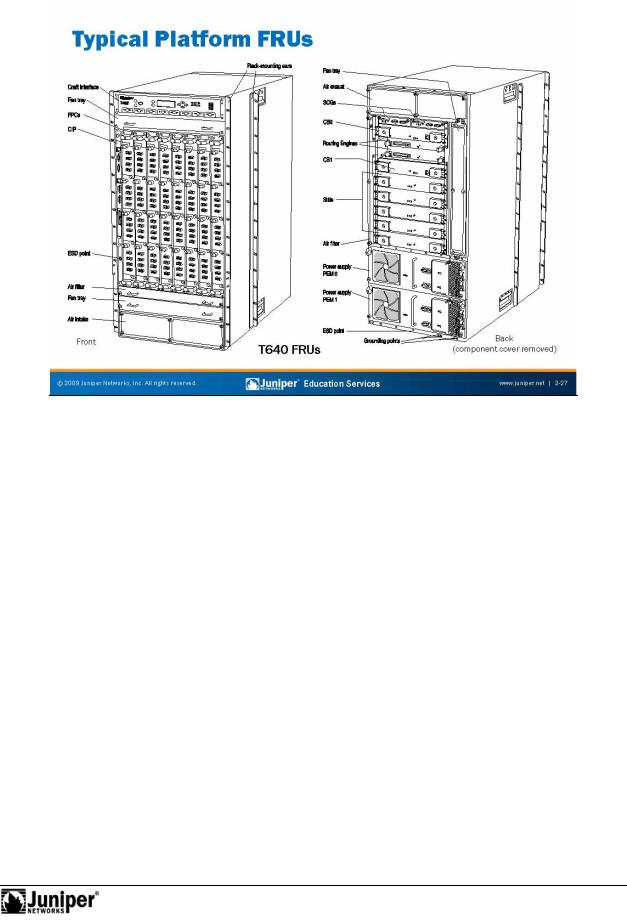
Troubleshooting JUNOS Platforms
|
|
|
Reproduction |
|
|
|
|
|
|
||
|
|
Typical Platform FRUs |
|||
|
|
All JUNOS platforms consist of a chassis and one or more FRUs. The slide shows the |
|||
|
|
primary F Us associat with the T640. |
|||
Not |
for |
|
|
|
|
|
|
|
|
||
Overview of JUNOS Platforms • Chapter 2–27
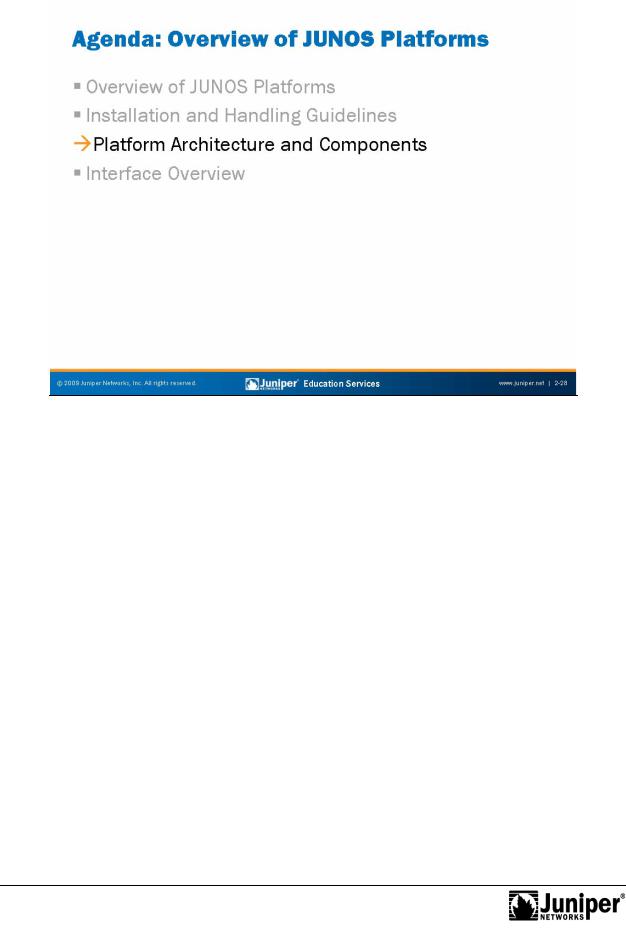
Troubleshooting JUNOS Platforms
|
|
|
Reproduction |
|
|
|
|
|
|
||
|
|
Platform Architecture and Com onents |
|||
|
|
The slide highlights the topic we discuss next. |
|||
Not |
for |
|
|
|
|
|
|
|
|
||
Chapter 2–28 • Overview of JUNOS Platforms
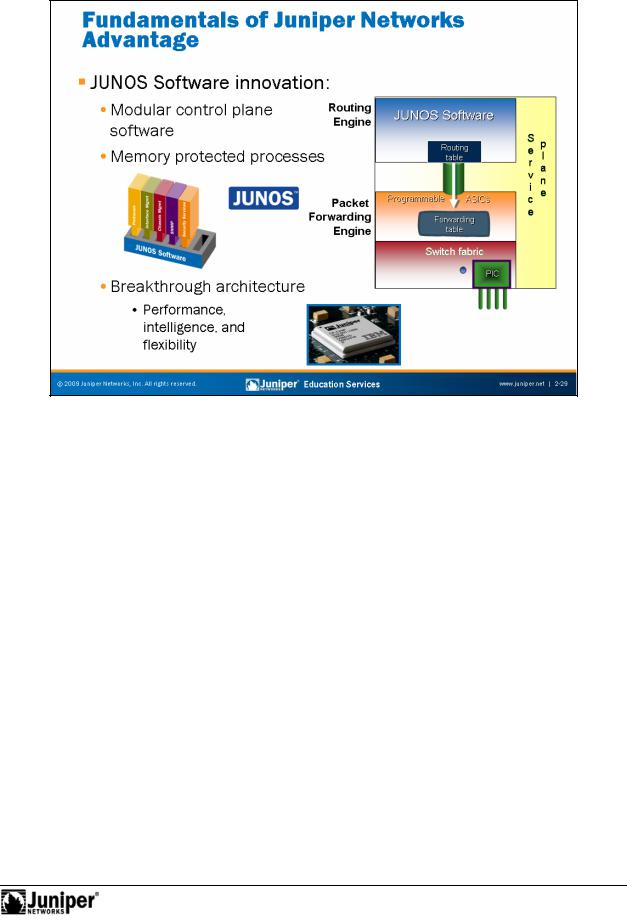
Troubleshooting JUNOS Platforms
JUNOSReproductionSoftware Innovation
The modular sign of the architecture of JUNOS platforms results in a clean separation of the control plane and the forwarding plane, facilitating rich packet processing through ASIC construction. The control plane is where routers talk to each
forother to determine topology and to set up services. The Routing Engine, which boasts dedicated hardware, represents the control plane. Running on top of the Routing Engine is the industry’s most proven and scalable operating system, JUNOS Software. The pe ating system might be the single most critical component of a high-performance device. JUNOS Software is a modular fault-protected operating system that can handle thousands of VPNs and BGP sessions and other types of
uting and signaling control information. Once the Routing Engine determines routing Not topology and services, it pushes that information down to the forwarding plane, or
PFE. The forwarding plane consists of programmable ASICs, which deliver very rich packet processing on a per customer basis, and it enables unparalleled forwarding performance.
Overview of JUNOS Platforms • Chapter 2–29
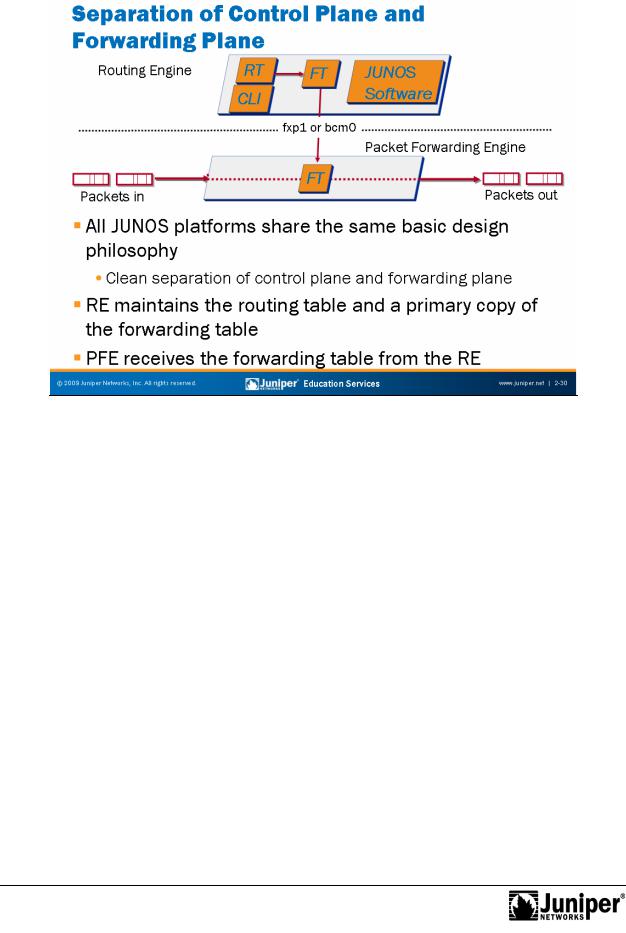
Troubleshooting JUNOS Platforms
|
|
|
Reproduction |
|
|
|
|
|
|
||
|
|
Architectural Philosophy |
|||
|
|
Architecturally, all JUNOS platforms share a common design that separates the |
|||
|
|
router’s control plane and forwarding plane. JUNOS platforms consist of the following |
|||
|
|
two major components: |
|||
|
|
• |
outing Engine: The RE is the brains of the platform; it is responsible for |
||
|
|
|
pe fo ming routing updates and system management. The RE runs |
||
|
|
|
va ious protocol and management software processes that live inside a |
||
|
|
|
p otected memory environment. The RE is a general-purpose computer |
||
|
|
|
platform based on an Intel microprocessor. It connects to the PFE |
||
|
|
|
through an internal 100 Mbps connection identified as fxp1 on most |
||
Not |
|
platforms. Some larger JUNOS platforms (such as the M320) use a |
|||
|
Gigabit Ethernet link, referred to as bcm0, between the RE and a Fast |
||||
|
|
forEthernet switch, which in turn has dedicated 100 Mbps links to each |
|||
|
|
|
FPC. |
||
|
|
• |
Packet Forwarding Engine: The PFE is responsible for forwarding transit |
||
|
|
|
packets through the router using an ASIC-based switching path. Because |
||
|
|
|
this architecture separates control operations—such as routing updates |
||
|
|
|
and system management—from packet forwarding, the router can deliver |
||
|
|
|
superior performance and highly reliable Internet operation. |
||
Continued on next page.
Chapter 2–30 • Overview of JUNOS Platforms

Troubleshooting JUNOS Platforms
Routing and Forwarding Table Interaction
The JUNOS Software routing protocol process implements the various routing protocols that run on the router. The routing protocol process starts all configured routing protocols and handles all routing messages. The routing protocol process (rpd) maintains one or more routing tables that consolidate the routing information learned from all routing protocols into common tables. From this routing information, the
RE and PFE Synchronization
routing protocol process determines the active routes to network destinations and installs Reproductionthese routes into the Routing Engine’s forwarding table.
The PFE receives the forwarding table from the RE. In the maj r |
y f cases, the PFE’s |
forwarding table and the RE’s forwarding table synchronize over |
he 100 Mbps fxp1 |
Ethernet link, which interconnects the two entities. This syn hron za on ensures that a change in topology produces identical forwarding tables in he RE and PFE. In the case of the M320 platform, a 100 Mbps Ethernet swit h provides a dedicated link to each FPC. These 100 Mbps links then presen to the M320 RE as a single Gigabit Ethernet uplink named bcm0. Forwarding table pdates are a high priority for the JUNOS Software kernel and it performs them incrementally.
Not |
for |
|
Overview of JUNOS Platforms • Chapter 2–31

Troubleshooting JUNOS Platforms
|
|
Reproduction |
|
|
|
|
|
|
|||
|
|
T Series Architecture |
|||
|
|
The T Series archit cture cl anly s parates control operations from packet forwarding |
|||
|
|
operations. This design liminat s processing and traffic bottlenecks, permitting the |
|||
|
|
router to achieve high performance. The router’s host subsystem—running JUNOS |
|||
|
for |
||||
|
|
Softwa e to handle routing protocols, traffic engineering, policy, monitoring, and |
|||
|
|
configu ation management—performs the control operation. The router’s PFEs— |
|||
|
|
consisting of ASICs—perform the forwarding operations. |
|||
|
|
The use dist ibuted memory and crossbar switching in the forwarding plane |
|||
|
|
c ntributes to a functional redundancy in the T series. Part of the distributed packet |
|||
|
|
rwarding architecture includes positioning of a PFE on each FPC, which adds to the |
|||
Not |
resiliency of the T Series devices. |
||||
Note that M120 and M320 routers deploy the T Series distributed memory |
|||||
|
|
||||
architecture.
Chapter 2–32 • Overview of JUNOS Platforms
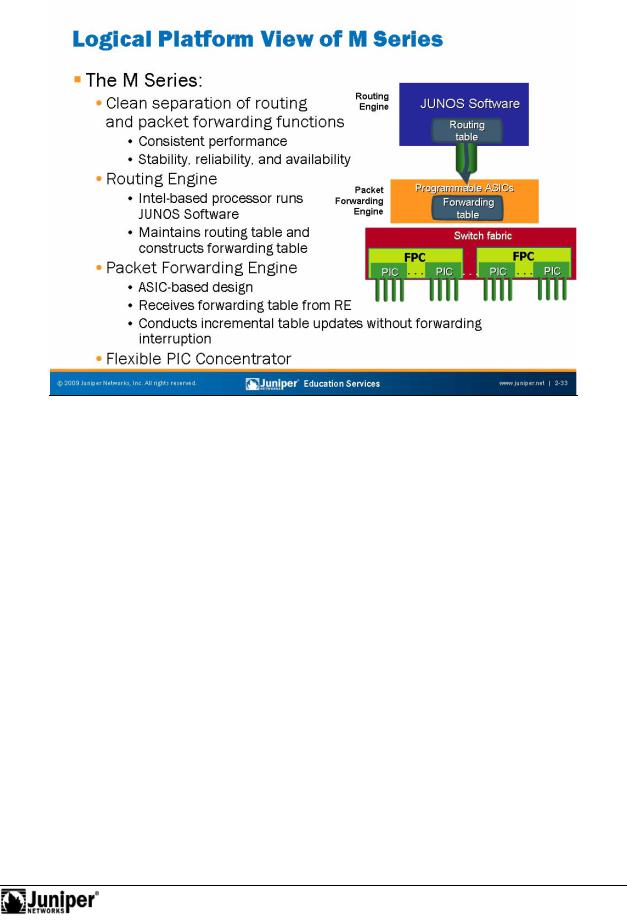
Troubleshooting JUNOS Platforms
|
|
p g ammableReproductionASICs—each of which is dedicated to a specific task. The PFE |
|
contains |
||
|
|
|
||||
|
|
Logical Platform Vi |
w of M Series |
|||
|
|
We design the M S |
ri s architecture with scale and stability in mind, including the |
|||
|
|
modular and fault-prot |
ct d design of JUNOS Software. M Series architecture offers a |
|||
|
|
clean separation of routing and packet forwarding functions, resulting in stable, |
||||
|
for |
|
|
|
||
|
|
p edictable, and reliable systems. The Intel-based RE is responsible for running |
||||
|
|
JUNOS Software, for performing routing updates, and for system management. The |
||||
|
|
PFE is the logical entity responsible for packet forwarding. It physically consists of |
||||
|
|
a c py of the forwarding table that matches the forwarding table copy in the RE. |
||||
|
|
Similar to the T Series, the M Series device architecture includes FPCs, which could |
||||
Not |
h use Physical Interface Cards (PICs). The M Series devices (with the exception of the |
|||||
M120 and M320) use a shared memory architecture. |
||||||
|
|
|||||
Overview of JUNOS Platforms • Chapter 2–33
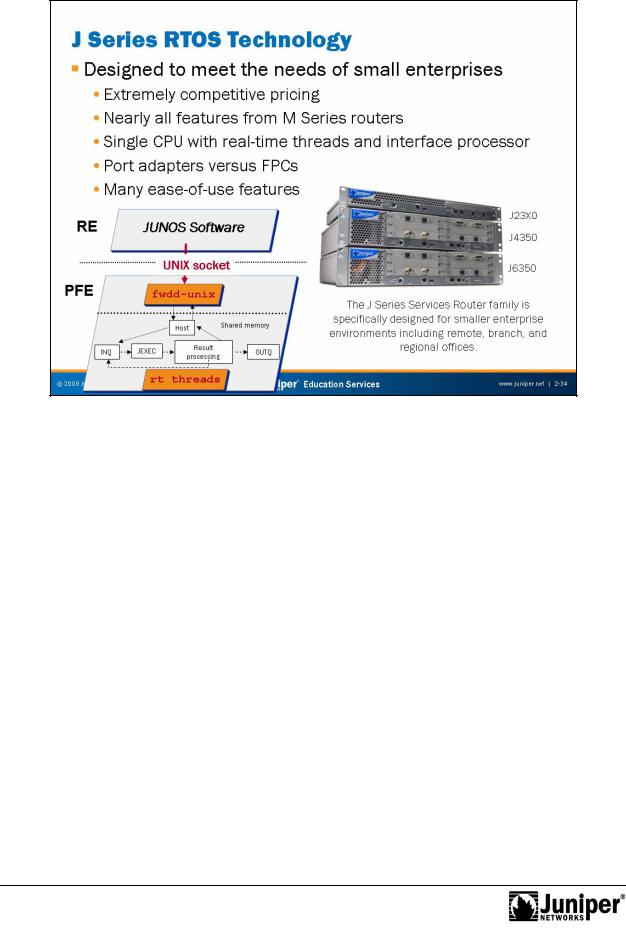
Troubleshooting JUNOS Platforms
Not
of the forwardingReproductionplane and control plane, but they feature the economical innovation of implementing this separation entirely in software. J Series routers use an RTOS to
J Series Routers
The J Series brings |
rministic forwarding performance and carrier-class stability to |
small enterprise and r |
mote offic s. These routers continue the practice of separation |
forno risk f ne function degrading the performance of any other function.
simultaneously implement JUNOS Software, packet forwarding, and advanced services, each in separate real-time threads. This practice enables these routers to pe m each f these functions with guaranteed and deterministic performance, with
J Series r uters use Physical Interface Modules (PIMs) instead of FPCs. A PIM is like an FPC with built-in PICs of a common media type. The PIMs have numerous low-speed WAN interfaces such as ISDN, xDSL, and serial, as well as LAN and high-speed uplink interfaces such as DS-3. All J Series routers include two embedded Fast Ethernet ports and an embedded software implementation of the Juniper Networks Adaptive Services PIC. Each port adapter contains Intel Interface Processors that offload some of the burden of packet processing from the CPU. As a result, when you add interfaces, you also proportionally add the necessary processing power to maintain the router’s performance capabilities with the additional connectivity.
Chapter 2–34 • Overview of JUNOS Platforms
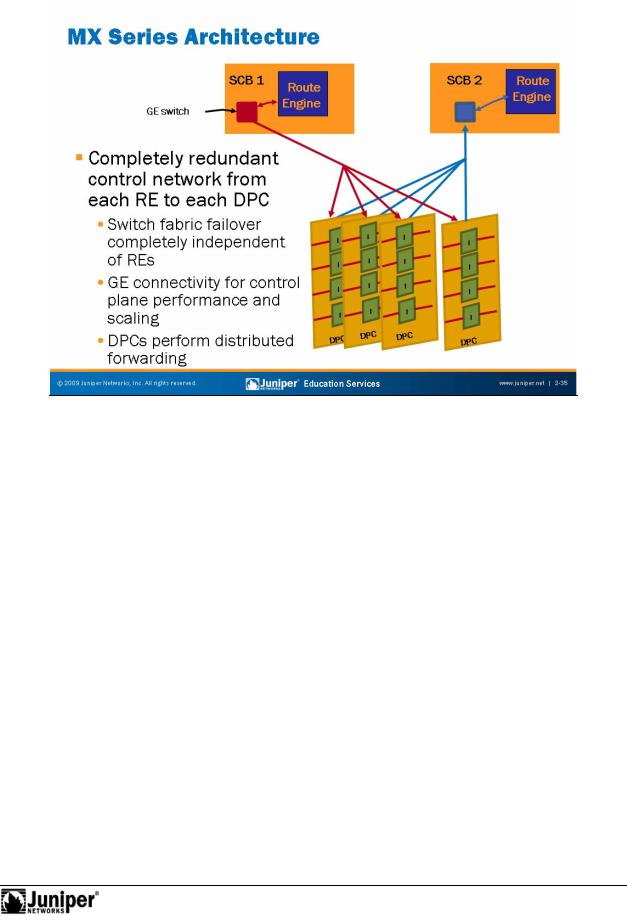
Troubleshooting JUNOS Platforms
|
|
independentReproductionfrom each other. |
|
|
|
|
|
|
|||
|
|
MX Series Archit |
cture |
||
|
|
Similar to core rout |
rs, MX Series devices are packet based and deploy distributed |
||
|
|
memory archit cture. The architecture includes RE redundancy, the control plane, the |
|||
|
|
SCB, and the DPCs. The control plane of th platform’s chassis consists of Gigabit |
|||
|
|
Ethe net links between the SCBs or REs and each DPC. Each SCB has a connection to |
|||
|
|
eve y DPC in the chassis, which in turn means that each RE has a redundant |
|||
|
|
connection to each DPC. The switch fabric failover and the RE failover are |
|||
|
|
The host subsystem consists of an RE functioning together with an SCB. The router |
|||
|
|
can have one or two host subsystems. If it has two host subsystems installed, one |
|||
Not |
functions as the master and the other functions as the backup. If the master host |
||||
|
forsubsystem (or either of its components) fails, the backup can take over as the master. |
||||
To operate, each host subsystem requires an RE installed directly into an SCB. If you configured the REs for graceful switchover, the backup RE automatically synchronizes its configuration and state with that of the master RE. Any update to the master RE state replicates on the backup RE. If the backup RE assumes mastership, packet forwarding continues through the router without interruption.
Overview of JUNOS Platforms • Chapter 2–35
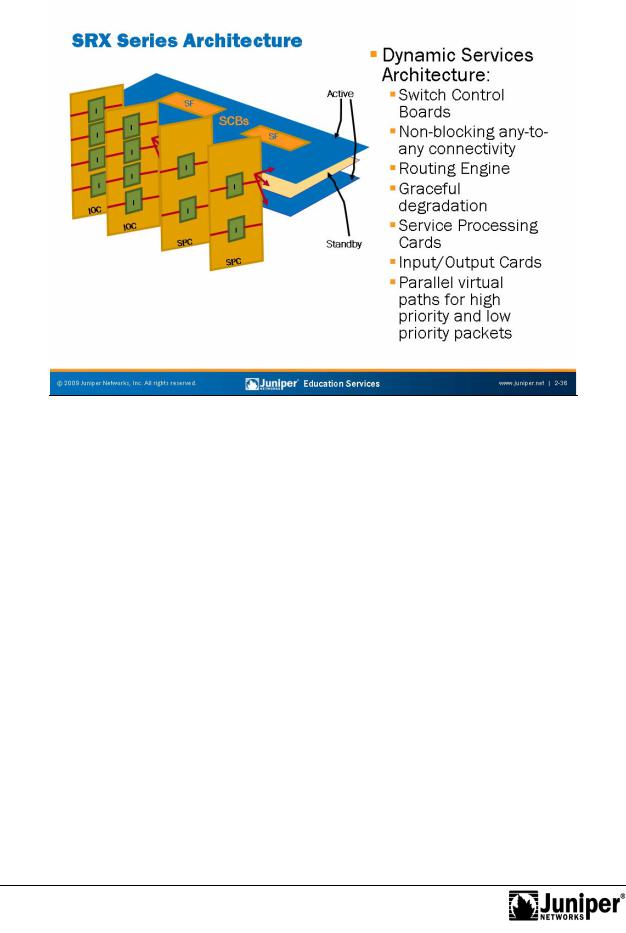
Troubleshooting JUNOS Platforms
|
Reproduction |
|
|
|
|
|
|||
|
SRX Series Archit |
cture |
||
|
SRX Series devices |
ploy Dynamic Services Architecture that includes the |
||
|
management and control n c ssary to incorporate individual blades into a powerful |
|||
collective solution. ather than housing disparate cards, the Dynamic Services |
|
for |
|
Architectu e adds each blade into a growing pool of resources. The SRX Series device |
|
can utilize these esources as necessary for optimal processing of traffic. |
|
At the hea t the Dynamic Services Architecture is the switch fabric and SCB. The |
|
SCB t ansf |
ms the chassis from a simple blade enclosure into a highly effective |
mesh netw |
rk. The purpose of the SCB is to allow all blades in the chassis to send |
tra ic at extremely high bandwidth. |
|
Not |
|
The RE tightly couples with the functionality of the SCB and we can consider it the central nervous system of the architecture. The RE is the control plane of the chassis and provides overall management and communications to and from system administrators, as well as calculating route tables for routing network traffic. JUNOS Software, which includes key chassis functionality, also runs on the RE. In the case of networking and security, functionalities such as advanced routing, switching, flow-based security, zone-based management, and screens are available in the software.
Chapter 2–36 • Overview of JUNOS Platforms
